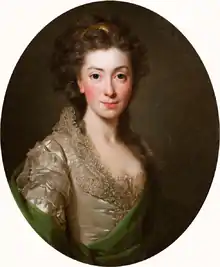Izabela Czartoryska
Elżbieta "Izabela" Dorota Czartoryska (née Flemming; 3 March 1746 – 15 July 1835) was a Polish princess, writer, art collector, and prominent figure in the Polish Enlightenment.
Izabela Czartoryska | |
|---|---|
 Portrait by Alexander Roslin | |
| Born | 3 March 1746 Warsaw, Poland |
| Died | 15 July 1835 (aged 89) Wysocko, Austrian Empire |
| Noble family | House of Czartoryski |
| Spouse(s) | Adam Kazimierz Czartoryski |
| Issue
Teresa Czartoryska Maria Anna Czartoryska Adam George Czartoryski Konstanty Adam Czartoryski Zofia Czartoryska Gabriela Czartoryska | |
| Father | Georg Detlev von Flemming |
| Mother | Antonina Czartoryska |
She was the wife of Adam Kazimierz Czartoryski and a member of the influential Familia political party.
She founded Poland's first museum, the Czartoryski Museum, now located in Kraków.
Life
She was the daughter of Count Georg Detlev von Flemming (Polish: Hrabia Jerzy Detloff Flemming) and Princess Antonina Czartoryska.[1]
On 18 November 1761, in Wołczyn, she married Prince Adam Kazimierz Czartoryski, thus becoming a princess.[2]
She was rumored to have had an affair with the Russian ambassador to Poland, Nikolai Vasilyevich Repnin, who was alleged to have fathered her son Adam George Czartoryski.[3]
She had also an affair with the Duke de Lauzun, who says himself in his "Mémoires" he fathered her second son Konstanty Adam.
In Paris in 1772, she met Benjamin Franklin, subsequently a leader of the American Revolution, and the French philosophers Jean-Jacques Rousseau and Voltaire, who were bringing new ideas to the old order.
In 1775, together with her husband, Czartoryska completely transformed the Czartoryski Palace at Puławy into an intellectual and political meeting place. Her court was one of the most liberal and progressive in the Commonwealth, although some aspects of her behavior also caused scandals.[4]
Izabela discovered the talent of the young painter Aleksander Orłowski and financed him.
While in Prussia with her daughter Maria Wirtemberska for the latter's marriage, she told Frederick II of her fears that her husband would be poisoned, which was what had caused a split between him and Stanisław August Poniatowski politically. Frederick laughed and told her that only monarchs were poisoned, and spread the conversation around his court to Izabela's detriment, according to Wirydianna Fiszerowa.[5]

In 1784, she joined the Patriotic Party.
After the suppression of the Kościuszko Uprising, her sons Adam George and Konstanty Adam were taken as political hostages by Russia's Empress Catherine II.
In 1796, Izabela ordered the rebuilding of the ruined palace at Puławy and began a museum. Among the first objects to be included were Turkish trophies that had been seized by Polish King Jan III Sobieski's forces at the 1683 Battle of Vienna. Also included were Polish royal treasures and historic Polish family heirlooms. In 1801 Izabela opened the Temple of the Sibyl, also called "The Temple of Memory".[6][7] It contained objects of sentimental importance pertaining to the glories and miseries of human life. During the November Uprising in 1830, the museum was closed. Izabela's son Adam George Czartoryski, going into exile in Paris, evacuated the museum's surviving objects to the Hôtel Lambert. His son Władysław Czartoryski would reopen the museum in 1878 in Kraków, where it exists today.[8]
Works
- Myśli różne o sposobie zakładania ogrodów (1805)
- Pielgrzym w Dobromilu, czyli nauki wiejskie (ca. 1818)
See also
References
- "IZABELA CZARTORYSKA – UWODZICIELKA, SKANDALISTKA, MECENASKA SZTUKI". Retrieved 2019-09-21.
- "Izabela Czartoryska - kochanka i kolekcjonerka". Retrieved 2019-09-21.
- LeDonne, John P. (2004). The grand strategy of the Russian Empire, 1650-1831. Oxford: Oxford University Press. ISBN 0195347692.
- Krzysztof Bauer (1991). Uchwalenie i obrona Konstytucji 3 Maja. Wydawnictwa Szkolne i Pedagogiczne. p. 70. ISBN 978-83-02-04615-5. Retrieved 2 January 2012.
- Fiszerowa, Wirydianna (1998). Dzieje moje własne (Polish translation ed.). Warsaw: Świat Książki.
- "Princess Izabela Czartoryska: Founder of Poland's First Museum". Retrieved 2019-09-21.
- "Shakespeare's Chair & Other Trophies: The Pilfering Polish Princess behind Europe's First Museum". Retrieved 2019-09-21.
- "Izabela Czartoryska. Pierwsza Dama Puław". Retrieved 2019-09-21.
External links
| Wikimedia Commons has media related to Izabela Czartoryska. |
